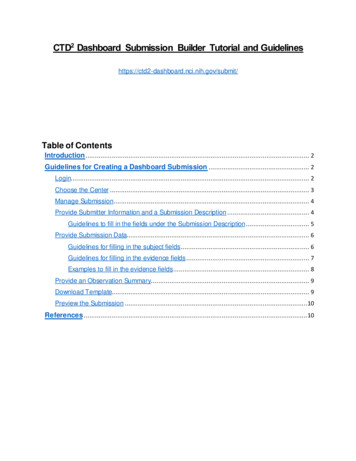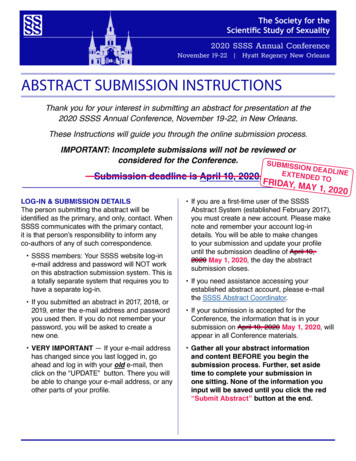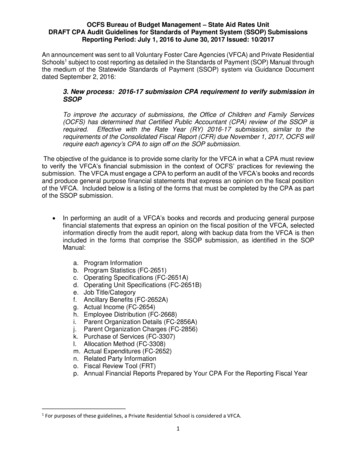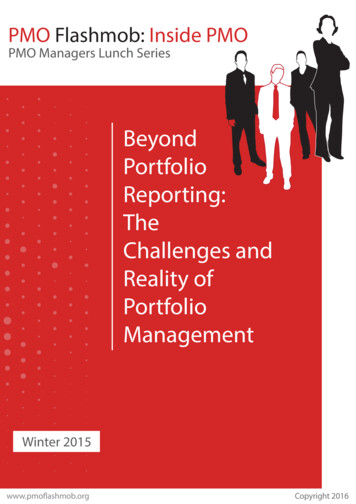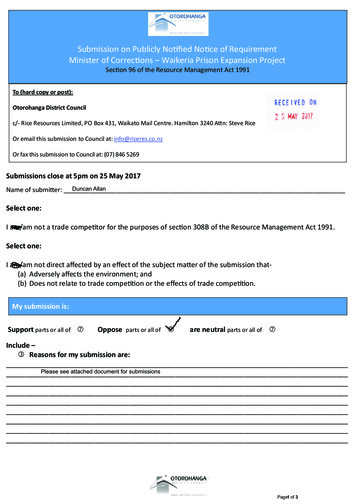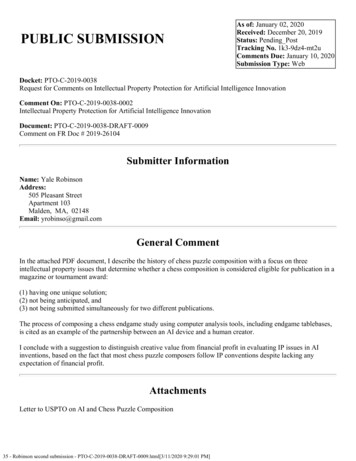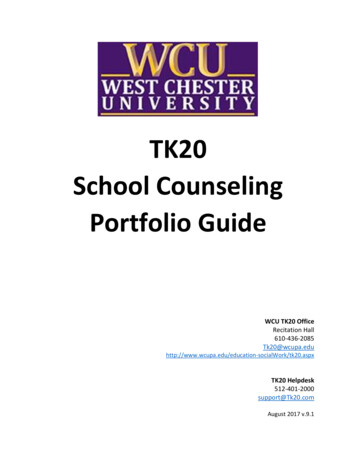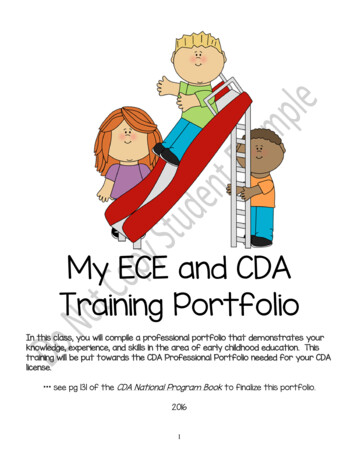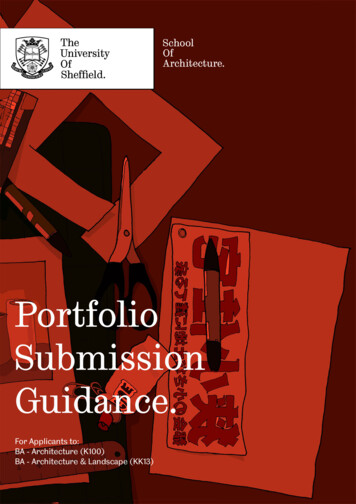
Transcription
or Applicants to:BA - Architecture (K100)BA - Architecture & Landscape (KK13)
What is a portfolio?During the degree course theportfolio represents the final versionof your work, which is marked bytutors at the end of each year andmight also be seen by externalexaminers.Each student’s portfolio becomesa reflective document, whichdescribes not only the projectsit contains, but also the thoughtprocess that has contributed to eachproject. Each student is thereforepersonally represented in theirportfolio. In most design-relateddisciplines a CV will need to includesome examples of work from yourportfolio and a job interview willinvolve presenting your portfolio.The editing and presentation skillsthat are required to produce aportfolio are valuable generic skillsfor any professional setting.The portfolio we ask you tosubmit as part of your applicationto this University will give us anunderstanding of not only yourrepresentational and creative skills,but also your critical thinking.This document should thereforecontain a selection of work that youthinks best demonstrates both yourcreative skills and the way you lookat the world around you. As you willnot be present to explain your workit is important that it is clear what itis, and laid out in a manner that youfeel best represents your approach.“What we want made visible are your perceptionof the subject, your skill in interpreting it, and yourmanual dexterity and control of media in producingthe representation.”Prof. Peter Blundell Jones“A good portfolio shouldnot only demonstratethe ability to observe,think and to representbut should also give aninsight into the characterof its author.” Susi ClarkSchool Of Architecture, The University Of Sheffield.2
What should your portfolio contain?People apply to the School ofArchitecture with a variety of skills,and having studied a number ofdifferent subjects: it is not alwaysthe case that applicants have studiedart at A-level for example, nor is thisneccessary. Work that demonstratesyour ability to think in threedimensions and your ability to usedifferent media is encouraged. Weare not interested in seeing lots ofdrawings of buildings at the expenseof any other work. If you choose torepresent buildings in your portfolioit may be useful to note why you havechosen a particular building or aparticular view of it.You may use the requirementto submit a portfolio as a way ofexperimenting with techniques thatyou have not used for some time orare, as yet, unfamiliar with.If your strengths lie in a particularfield, think of how you can use thisin an innovative and appropriateway - for example you may not feelcomfortable with drawing freehand(although this is a useful skill topractise) and want to produce amodel that is then photographed ina particular way. Remember that wewill be looking at a large volume ofportfolios and a distinctive approach,or work that shows a clear insightinto the subject matter, will standout. What is vital is that all worksubmitted is original, i.e. it is all yourown work.Work suitable for inclusion as part of your portfolio may include:Drawing[ i.e. Pen/Pencil/Charcoal of Objects/Buildlings/People etc ]Painting[ i.e. Watercolour/Oil/Acylic - figurative/abstract]Screen-printingTypography[ i.e. font design, lettering layout ]Graphic Design[ i.e. Poster, Magazine, Flyer, Book ]Sculpture[ Small or large scale, wood/metal/plastic/clay etc. ]Ceramics[ i.e. pottery, sculptural ]Textile Design[ i.e. 2-d pattern design, creation ofthe fabrics themselves ie weaving ]Fashion Design[ Design of clothing, or the making ofclothing ]Theatrical Work[ Stage set design, Lighting, Costume[ Furniture, Building, ]Product DesignStill Photography[ Development sketches to finalised/built designs ][ To highlight compositional skills and/or observational skillsFilm[ stills or short films ]Jewellery[ design, or finished peices ]Collage[ digitial, paper, fabric, mixed media ]Animation[ stills only ]School Of Architecture, The University Of Sheffield.3
Putting together your portfolioWe now ask that your portfolio issubmitted digitally by email.As with a hard (i.e. paper) copy of yourwork, there are certain guidelinesthat still apply. Your work should beeasy to look through and it should beclear what each piece is – rememberthat you are not there to explainindividual items to the people lookingat your portfolio. Text, neat labels,or a sheet of contents, for example,can all help to explain what you haveproduced. Give a value to what you doand make sure that you present it in away that does the work justice - thismight mean that that you produce a‘cover’ page, or carefully consider thelayout and order of images submitted.Details of how to submit your portfoliowill be provided in a separate email,after you have made your application.Photographing / scanning WorkAs you will be submitting photos of3-dimensional work, and photos orscans of 2-dimensional work, ensurethat: Photographs are taken at aresolution that ensures that thefile you submit is easy to see andis not distorted or blurred;If you are photographing2-dimensional work youphotograph this with the cameraat right angles to the art work sothat the image is not distorted; You photograph your workunder bright natural or artificiallight (don’t use flash) and checkthat colours and details are trueto the original;You photograph your workagainst a neutral background(black works best for art/drawings) so that this doesn’tdetract from the artwork;If you are scanning a drawing,you check that the resolutionis set high enough and that theimage isn’t too small.File FormatThe most important thing is thatyour work is easy to see. If yousubmit files that cannot be opened,no matter how good the quality ofyour work, it won’t be seen.We prefer you to combine all of yourwork into one file, allowing you tocontrol the order that your workis seen in and to add a title pageor contents page. We accept thefollowing file formats for combinedfiles: Adobe Acrobat (.pdf), MS Word(.doc or .docx) and MS Powerpoint(.ppt or .pptx).We generally advise againstsubmitting a collection of singleimage files (i.e. .jpgs) as this is timeconsuming to look through for staffwho have large volumes of portfoliosto assess. If it is unavoidable, makesure to label files clearly, numberthem and provide a cover sheet orkey.We cannot accept archived files (ZIP,RAR etc.), and you must ensure that,uncompressed, your chosen filetype is no larger than 6Mb.Note, we are unable to review videoor audio clips. If you wish to includeanimation work, please submit aselection of still images.“The best portfoliosare those that showpersonal explorations,experiments, andreflections, through avariety of techniques andtypes of work”Dr Cristina Cerulli“A good portfolio would reflect the candidate’s owninterests and passions so that we are able to findout the context for their drive to explore and studyarchitecture” Dr Rosie ParnellSchool Of Architecture, The University Of Sheffield.4
And one more thing.“I’m not especiallyinterested in looking ataccomplished artwork.What is more importantis that drawingsdemonstrate a sense ofexploring a set of ideasin an imaginative andthoughtful way.” Russell LightAs a further test of your critical,representational and observationalskills, we ask that you submit a pieceof work that illustrates an aspect ofthe street/road/lane that you liveon. This can be in any medium andshould be accompanied by a shorttext of around 200 words.We are interested in a creative,rather than strictly descriptive,approach. For example, astraightforward sketch of the houseopposite yours may show howwell you can sketch, but it will notnecessarily demonstrate your abilityto look beyond what is immediatelyapparent.You do not have to live in an area ofparticular architectural significance,in fact looking below the surface ofwhat you consider to be an ‘ordinarystreet’ may create more interestingpieces of work.Exploring the textures, patterns,scale, details, signage, localinhabitants and signs of life, patternsof use or the atmosphere orcharacter at different times, mayresult in a much more individualapproach.all the same or do they differ slightlyand how/why? Questioning andmaking yourself think in more detailwill help you with this task.The text accompanying yourrepresentational work should,similarly, be imaginative, insightfuland expressive, and not purelydescriptive. We are much moreinterested in your critical approachto your piece of work and not thetechniques that you have used tomake it.What is the character of the area?Why? Who lives there? Why are thehouses all the same? Are they reallySchool Of Architecture, The University Of Sheffield.5
“I am not bothered about the presentationof great skill in replicating a specific artstyle (impressionism, cubism, pop etc.).What I like is when I see that someonetook these skills and made somethingelse with them, shifted them to anothermeaning, or applied them in a differentway. There must be a certain level ofreflection that becomes apparent in thework”. Dr. Florian KossakFor more informationwww.sheffield.ac.uk/architecture(for contact emails & telephone numbers)“For me, the most useful portfolios arethose that carry something of thepersonality of their authors; this usuallycomes through in ‘drawings’ (orsheets, or whatever you call them) thatare experimenting, trying thingsout, and not always succeeding. Thesekinds of ‘drawing’ reveal much morethan generic, highly polished and finishedthings.” Stephen Walker
portfolio. In most design-related disciplines a CV will need to include some examples of work from your portfolio and a job interview will involve presenting your portfolio. The editing and presentation skills that are required to produce a portfolio are valuable generic skills for any professional setting. The portfolio we ask you to
